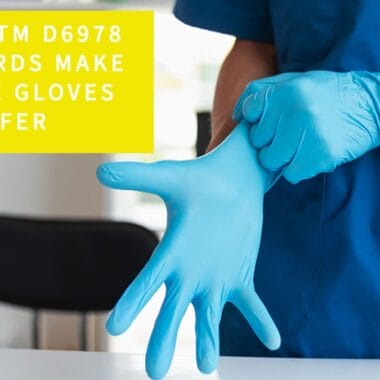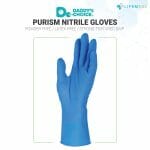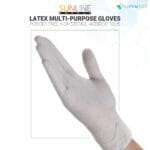Personal protective equipment (PPE) is crucial for guarding against bacterial infections, providing a physical barrier between the user and pathogens. Wearing PPE helps minimize the risk of spreading and exposure to harmful bacteria. PPE gloves, like 5 mil nitrile gloves, ensure that healthcare workers, researchers, and other professionals can safely operate in contaminated environments without direct contact with pathogens. While wearing nitrile gloves is essential for protecting yourself, it also prevents spreading bacteria to other individuals, surfaces, or environments.
When bacterial infections like Necrotizing Fasciitis are prevalent, properly using nitrile gloves is a foundational element of infection control, protecting professionals and the community.
What is Necrotizing Fasciitis?
Necrotizing fasciitis is a rare but severe bacterial infection that affects the tissue beneath the skin, surrounding muscles, and organs (known as the fascia). It’s sometimes referred to as a “flesh-eating” disease—although the bacteria don’t actually “eat” the flesh, they release toxins that destroy the tissue.
The most common way to get necrotizing fasciitis is by the bacteria entering the body through an open wound. The infection can begin from a minor cut, insect bite, surgical wound, or even where there is no apparent break in the skin. Necrotizing fasciitis can be caused by several types of bacteria, such as Group A Streptococcus (GAS), Staphylococcus aureus, Clostridium, Escherichia coli, Klebsiella, Aeromonas, and hydrophila.
Signs and Symptoms of Necrotizing Fasciitis
The early signs of necrotizing fasciitis can be vague and may include pain or soreness, fever, chills, and red or swollen skin around the affected area. More severe cases of necrotizing fasciitis may cause blisters or black spots on the skin, oozing of pus, or dark, vile-smelling fluid from the wound. Affected individuals may also experience dizziness, fatigue, nausea, or diarrhea due to necrotizing fasciitis.
The infection can lead to sepsis, organ failure, and death without prompt treatment. Even with treatment, necrotizing fasciitis is fatal in up to one-third of cases. Survivors might require reconstructive surgeries and rehabilitation and may suffer from long-term complications. Wearing five mil nitrile gloves can shield the skin from coming in contact with potential sources of infection. Especially if you have an open wound on your hands, wearing PPE gloves provides a barrier between your skin and any surface you come in contact with.
To prevent necrotizing fasciitis, practicing good wound care is essential. Any cuts or abrasions on your hands should be cleaned and protected with nitrile gloves. Those with chronic health conditions or weak immune systems should prioritize proper hand hygiene and safety precautions to avoid sources of infection.
The Strength and Durability of Nitrile Gloves Against Bacterial Infections
Nitrile gloves protect against hazards, including infections like Necrotizing Fasciitis. The primary function of nitrile gloves is to act as a barrier, preventing bacteria and other pathogens from coming into direct contact with the skin. Made of durable synthetic rubber, nitrile gloves are resistant to many chemicals, which ensures that external disinfectants or antiseptics don’t come in contact with the protected skin. Nitrile’s high puncture resistance to sharp objects or tools is crucial when handling potentially contaminated materials.
A punctured glove could provide a pathway for harmful bacteria to contact the exposed skin. Nitrile gloves offer a snug fit, boosting dexterity and minimizing the risk of tears or punctures during activity. Their non-porous features prevent bacteria and viruses from quickly penetrating or entering the glove. Nitrile gloves being latex-free reduces the potential risk for allergic reactions and skin sensitivities. Sterile nitrile gloves are the best contaminant-free PPE for procedures requiring an aseptic environment.
Frequent glove changes between tasks help users fully benefit from the protective features of nitrile gloves. While 5 mil nitrile gloves provide a substantial barrier against bacterial infections, proper safety precautions and infection control practices should be followed, especially in high-risk environments.
Best Practices for Using 5 mil Nitrile Gloves
When wearing nitrile gloves for hand protection, adhering to best practices can maximize their protective qualities and minimize the risk of contamination. Wash your hands with soap and water for approximately 20 seconds, and make sure they are dry before putting on nitrile gloves. Inspect the gloves for any visible tears, holes, or defects in the material before use. Ensure that your PPE gloves are the perfect size and fit for dexterity and to prevent potential tears. The glove should fit snugly around fingers and palms for proper fit. Once you have the gloves on, avoid touching non-sterile surfaces like phones, doorknobs, or your face. Touching these surfaces contaminates the glove and also risks contaminating everything you touch.
Nitrile gloves are disposable, single-use gloves, meaning they should be disposed of after each use to prevent cross-contamination. When carefully removing your gloves, ensure the outside of the glove does not come in contact with your skin. After disposing of the gloves, wash your hands immediately using soap and water or hand sanitizer. Consider double-gloving your nitrile gloves in high-risk situations where exposure to necrotizing fasciitis is possible. Doubling up on your gloves might reduce dexterity, but can be necessary in cases where additional protection is needed.
Prioritizing Safety Against Necrotizing Fasciitis with Nitrile Gloves
Prioritizing safety when using nitrile gloves is paramount, especially in environments where exposure to contaminants and pathogens is a concern. These PPE gloves are the primary barrier between the skin, potential hazards, and bacterial infections like necrotizing fasciitis. Nitrile gloves ensure that professionals, from healthcare workers to lab technicians, remain safe during tasks.
A lapse in safety practices, such as reusing gloves, not changing them when contaminated, or improper donning and doffing, can compromise this protective barrier, leading to potential infections, chemical exposures, or cross-contamination. Given the rising awareness of diseases that can be easily transmitted through contact, nitrile gloves have become more critical than ever. Ensuring safety with these gloves safeguards the user and protects patients, coworkers, and the community from potential risks.
References:
- National Library of Medicine, 2023. Necrotizing Fasciitis.
- Centers for Disease Control and Prevention (CDC). Necrotizing Fasciitis: All You Need to Know.
- Centers for Disease Control and Prevention (CDC). What is Sepsis?


















